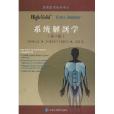基本介紹
內容簡介
作者簡介
作者:(美國)杜德克(Ronald W.Dudek) (美國)路易斯(Thomas M.Louis)
圖書目錄
Preface
1 Vertebral Column
Ⅰ.The Vertebral Coulumn
Ⅱ.Curves
Ⅲ.Joints
Ⅳ.Vasculalure of the Vertebral Column
Ⅴ.Clinical Considerations
Ⅵ.Normal Radiology
2 Spinal Cord and Spinal Nerves
Ⅰ.Components of the Spinal Cord
Ⅱ.Meninges and Spaces
Ⅲ.Arterial Supply of the Spinal Cord
Ⅳ.Components of a Spinal Cord
Ⅴ.Dermatomes
Ⅵ.Clinical Proceclures
Ⅶ.Clinical Considerafions
3 Autonomic Nervous System
Ⅰ.General Features of the Nervous System
Ⅱ.Sympathetic Division of the ANS (Thoracolumbar)
Ⅲ.Parasympathetic Division of the ANS (Craniosacral)
Ⅳ.Summary Table of Sympathetic and Parasympathetic Motor Actions
4 Lymphatic System
Ⅰ.Central Lymphatic Drainage
Ⅱ.Summary Diagram of Specific Lymphatic Drainage
5 Chest Wall
Ⅰ.General Features of the Thorax
Ⅱ.Bones of the Thorax
Ⅲ.Muscles of the Thorax
Ⅳ.Movement of the Thoracic Wall
Ⅴ.Arteries of the Thorax
Ⅵ.Veins of the Thorax
Ⅶ.Nerves of the Thorax
Ⅷ. Breast
Ⅸ. Anterior Chest Wall
Ⅹ. Lateral Chest Wall
Ⅺ.Posterior Chest Wall
Ⅻ.Mediastinum
ⅩⅢ. Radiology
6Pleura, Tracheobronchial Tree, and Lungs
Ⅰ.Pleura
Ⅱ.Tracheobronchial Tree
Ⅲ. Lungs
Ⅳ. Clinical Considerations
Ⅴ. Cross-sectional Anatomy
7 Heart
Ⅰ.The Pericardium
Ⅱ.Heart Surfaces
Ⅲ. Heart Borders
Ⅳ. Fibrous Skeleton of the Heart
Ⅴ. VaNes and Auscultation Sites
Ⅵ.Arterial Supply of the Heart
Ⅶ.Venous Drainage of the Heart
Ⅷ. The Conduction System
Ⅸ. Innervation of the Heart
Ⅹ. Gross Anatomy of the Heart
Ⅺ. Clinical Considerations
Ⅻ.Radiology
8 Abdominal Wall
Ⅰ.Abdominal Regions
Ⅱ.Clinical Procedure
Ⅲ. Inguinal Region
Ⅳ. The Scrotum
9 Peritoneal Cavity
Ⅰ.Peritoneal Cavity
Ⅱ.Omentum
Ⅲ. Intraperitoneal and Extraperitoneal Viscera
Ⅳ. Clinical Considerations
10 Abdominal Vasculature
Ⅰ.Abdominal Aorta
Ⅱ.Venous Drainage of the Abdomen
Ⅲ. Hepatic Portal System
……
11 Abdominal Viscera
12 Sigmoid Colon, Rectum, and Anal Canal
13 Spleen
14 Kidney, Ureter, Bladder, and Urethra
15 Suprarenal (Adrenal)Glands
16 Female Reproductive System
17 Male Reproductive System
18 Pelvis
19 Perineum
20 Upper Limb
21 Lower Limb
22 Head
23 Neck
24 Eye
28 Ear
Appendix 1: Muscles of the Arm
Appendix 2: Muscles of the Leg
Credits
Index
文摘
著作權頁:
插圖:
b. When a person is supine aspirated material most commonly enters the right lower lobar bronchus and lodges within the superior bronchopulmonary segment (#6) of the right lower lobe.
c. When a person is lying on the right side aspirated material most commonly enters the right upper lobar bronchus and lodges within the posterior bronchopulmonary segment (#2) of the right upper lobe.
d. When a person is lying on the left side aspirated material most commonly enters the left upper lobar bronchus and lodges within the inferior lingular (#5) bronchopulmonary segment of the left upper lobe.Lungs (Figure 6-3)
A. RIGHT LUNG
1. The right lung consists of three lobes (upper, middle, and lower) separated by a horizontal fissure and an oblique fissure.
2. The horizontal fissure runs at the level of costal cartilage 4 and meets the oblique fissure at the midaxillary line.
3. The diaphragmatic surface consists of the middle lobe and lower lobe.
B. LEFT LUNG
1. The left lung consists of two lobes (upper and lower) separated by an oblique fissure.
2. The left upper lobe contains the cardiac notch, where the left ventricle and pericardial sac abut the lung. The lingula (which is the embryologic counterpart to the right middle lobe) lies just beneath the cardiac notch.
3. The diaphragmatic surface consists of the lower lobe.
C. BRONCHOPULMONARY SEGMENT
1. The bronchopulmonary segment contains a segmental bronchus, a branch of the pulmonary artery, and a branch of the bronchial artery, which run together through the central part of the segment.
2. The tributaries of the pulmonary vein are found at the periphery between two adjacent bronchopulmonary segments. These veins form surgical landmarks during segmental resection of the lung.
3. The bronchopulmonary segments are both named and numbered as follows:
a. Right Lung
Ⅰ. Upper lobe: apical (#1), posterior (#2),* anterior (#3)
Ⅱ. Middle lobe: lateral (#4), medial (#5)
Ⅲ. Lower lobe: superior (#6), medial basal (#7), anterior basal (#8), lateral basal (#9), posterior basal (#10)
b. Left Lung
Ⅰ. Upper lobe: apical (#1), posterior (#2), anterior (#3), superior lingular (#4), inferior lingular (#5)
Ⅱ. Lower lobe: superior (#6), anterior basal (#8), lateral basal (#9), posterior basal (#10); note that #7 is absent.
D. BREATH SOUNDS
1. Breath sounds from the upper lobe of each lung can be auscultated on the anteriorsuperior aspect of the thorax.
2. Breath sounds from the lower lobe of each lung can be auscultated on the posteriorinferior aspect of the back.
3. Breath sounds from the middle lobe of the right lung can be auscultated on the anterior thorax near the sternum just inferior to intercostal space #4.

